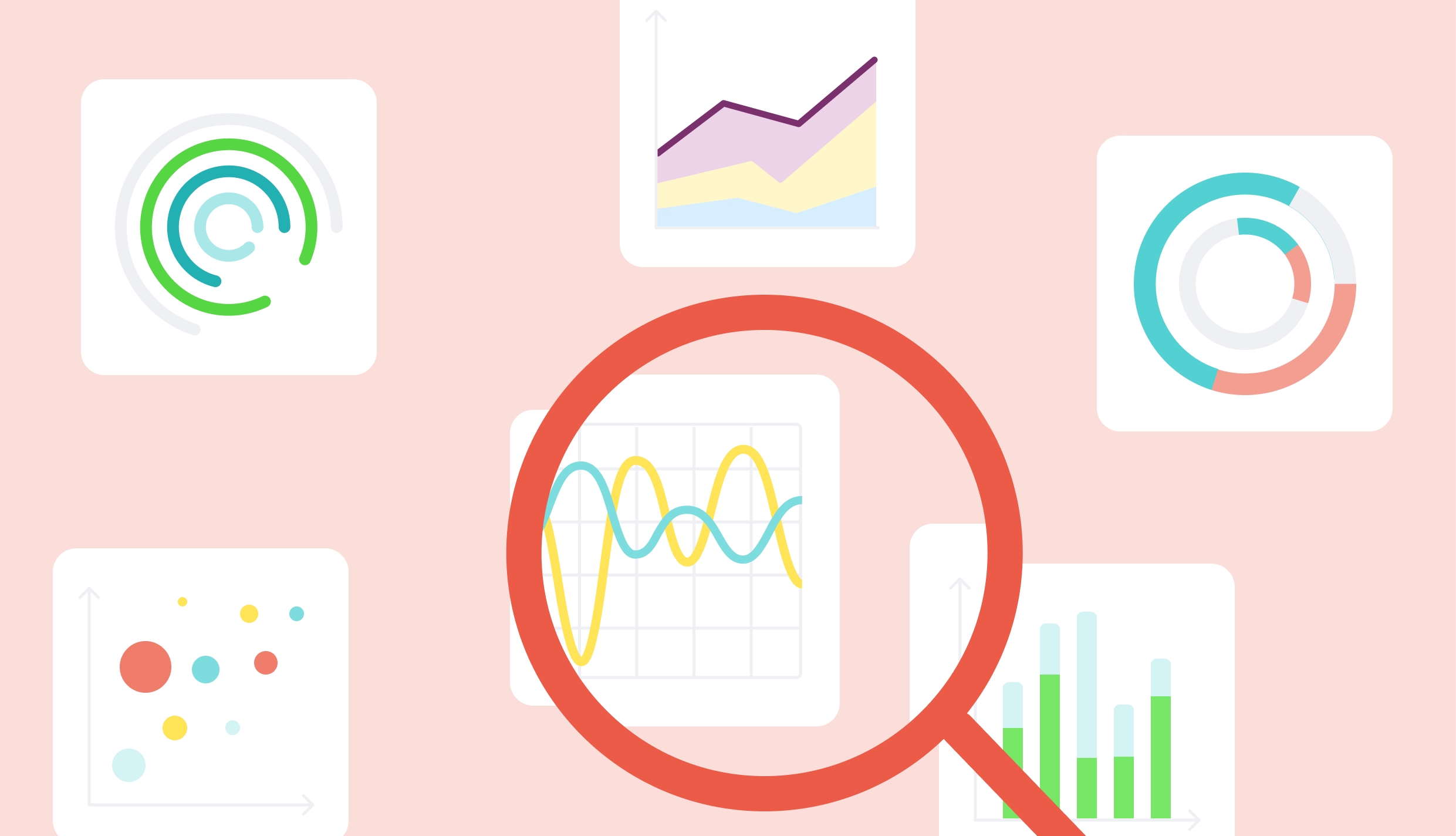In the professional services industry, project management metrics are vital. However, it’s important to recognize that success goes beyond profitability and growth. Relying solely on these metrics provides only a partial view of performance. To dig deeper and gain comprehensive insights into what’s working and what might need improvement, firms should optimize all four metrics outlined below to ensure enduring success.
4 Metrics for Project Management
By focusing on all four of these project management metrics, firms can proactively identify areas of strength and weakness, allowing them to make necessary adjustments to stay ahead of the curve.
- Revenue growth
- Organizational profit
- Client satisfaction
- Employee optimization
Revenue Growth
Why You Should Track Revenue Growth
Assessing Project Effectiveness
Tracking revenue growth enables firms to assess the success and profitability of their projects. It serves as a key metric for evaluating project outcomes and identifying areas where improvements can be made to enhance project performance.
Competitiveness
Firms with steady revenue growth show they can attract new clients and identify opportunities, showcasing their adaptability and resilience in project delivery.
Diversification
Revenue growth often accompanies business expansion. Firms can diversify their income streams, enter new markets, and offer additional services. This diversification reduces the risk associated with relying heavily on a specific client segment or market.
How to Track Revenue Growth
Percentage of Bids Won
Maximizing bid success rates ensures a steady revenue stream, significantly contributing to overall organizational growth.
The table below shows the direct effect the percentage of bids won has on revenue growth for professional services firms.

Sales Pipeline
A well-managed sales pipeline is crucial for measuring revenue growth, enabling the identification and securing of projects. Effective pipeline management ensures a steady flow of business opportunities, contributing to sustained revenue growth.
Regular Financial Analysis
Routinely review financial statements, including income statements, balance sheets, and profit and loss statements. These documents provide a historical perspective on revenue growth.
Growth Rate Calculation
Calculate growth rates using the formula: [(Current Period Revenue – Previous Period Revenue) / Previous Period Revenue] * 100. This formula quantifies the rate of revenue growth as a percentage.
Customer Acquisition Metrics
Keep a close eye on the number and value of new contracts or clients acquired. This data provides insights into the sources of revenue growth and the effectiveness of sales strategies.
Sales Funnel Analysis
Analyze the sales funnel to understand conversion rates at each stage. This reveals where potential revenue growth opportunities exist, whether it’s in lead generation, proposal conversion, or client retention.
Organizational Profit
Why You Should Track Organizational Profit
Financial Health
Profit is a fundamental indicator of a company’s financial well-being. It shows whether the organization is generating more income than it spends, ensuring its sustainability and ability to have recurring project profitability.
Risk Mitigation
Monitoring profits provides a financial cushion that allows firms to weather unexpected challenges or economic downturns. It enables them to continue operations and investments, reducing vulnerability to outside factors.

Decision Making
Understanding profits helps in making informed decisions about investments, cost reductions, pricing strategies, and other aspects of the business that can impact financial performance.
How to Track Organizational Profit
Employee Billable Utilization Rates
Boosting net profit requires a continuous focus on enhancing both employee billable utilization and the percentage of billable employees. Increasing these factors contributes significantly to improving overall profit margins, as shown in the table below. Learn more about utilization rates and how to measure them.
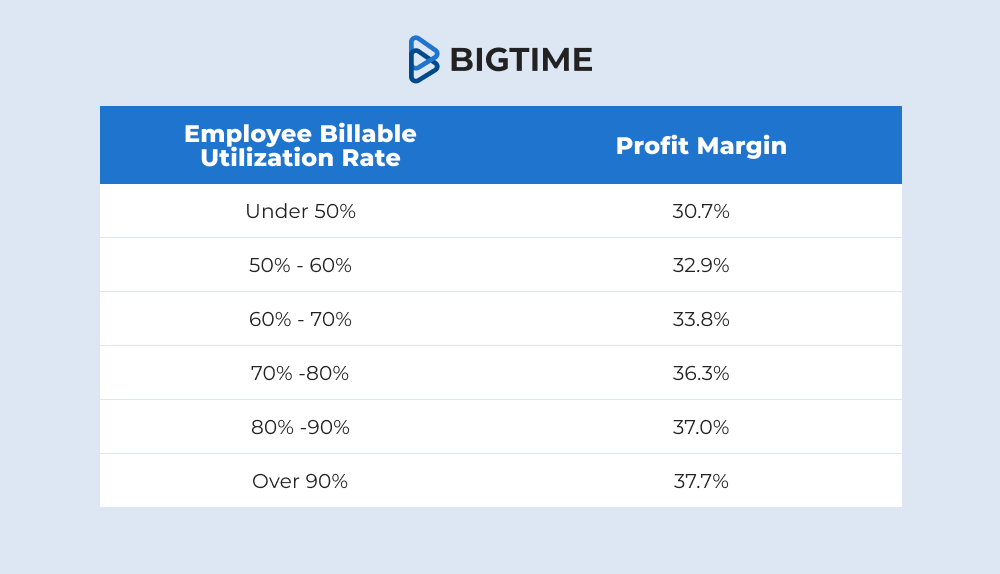
Profit Margin Calculation
Calculate profit margins to assess how much profit is generated for each dollar of revenue.
Financial Statements
Regularly review income statements and balance sheets to monitor profit trends and overall financial health.
Cost Analysis
Monitor cost structures to identify areas where expenses can be optimized, improving profit margins.
Client Satisfaction
Why You Should Track Client Satisfaction
Reputation and Loyalty
When clients are satisfied with project outcomes, it contributes to a positive reputation for the firm and fosters client loyalty. Satisfied clients are more likely to stay with the firm, trust its services, and be less price-sensitive and more willing to accept service expansions or upsells.
Referral Network
Happy clients can become valuable sources of referrals. Their recommendations can bring in new business, reducing client acquisition costs and contributing to organic growth.
Service Improvement
Client feedback and satisfaction surveys provide valuable insights into areas that require improvement, helping the firm enhance project quality and meet client expectations more effectively.
In the table below, you can see how influential having referenceable clients is in achieving your annual revenue goals.
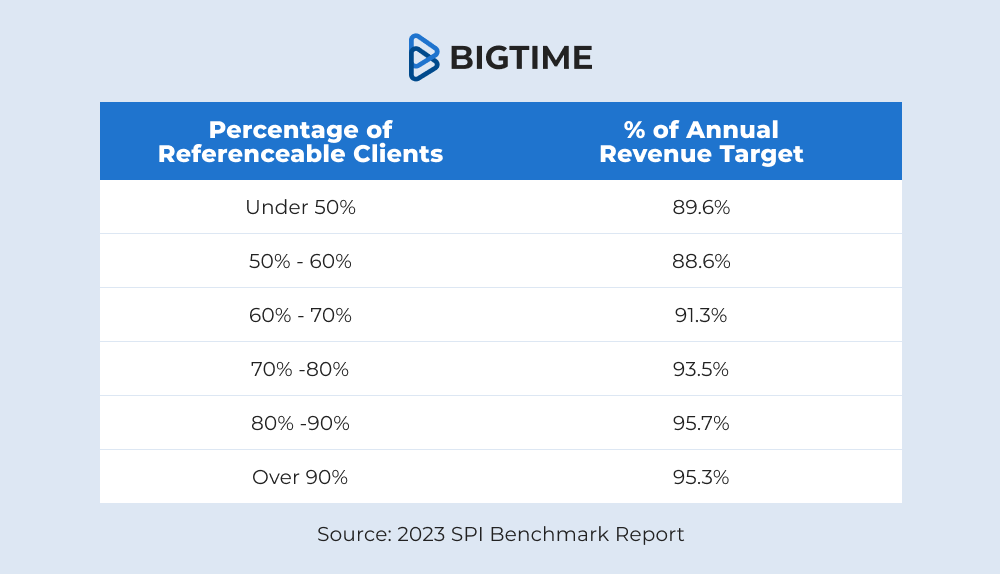
How to Track Client Satisfaction
Post-Project Engagement Interviews
Post-project engagement interviews offer a direct line to client feedback after project completion. These conversations drive continuous improvement, shaping service delivery and reinforcing the firm’s commitment to excellence
Client Retention and Referral Rates
Measure project management performance by analyzing client retention rates and the number of referrals received from existing clients. These are indicators of overall satisfaction and loyalty.
Net Promoter Score (NPS)
NPS is a widely used metric that measures client loyalty. Clients are asked to rate their likelihood of recommending the firm to others on a scale of 0 to 10. Based on their responses, clients are categorized as promoters (score 9-10), passives (score 7-8), or detractors (score 0-6).
Customer Satisfaction Score (CSAT)
CSAT measures client satisfaction with services using a simple rating scale, typically from 1 to 5. It provides a quick and easily interpretable measure of client contentment.

Employee Optimization
Why You Should Track Employee Optimization
Service Excellence
Engaged and motivated employees are more likely to deliver high-quality projects, creating a positive feedback loop that enhances the firm’s reputation and client satisfaction.
Attraction and Retention
A positive workplace culture that emphasizes employee development can help attract and retain top talent, giving the firm a competitive edge in recruiting.
On-Time Project Delivery
A workforce that is well-trained, motivated, and aligned with project goals ensures efficiency and effectiveness throughout the project lifecycle, contributing to the financial health of an organization. Timely project completion not only meets client expectations but also enhances the firm’s reliability, improving client satisfaction and loyalty. Learn how PSA software keeps your projects profitable in every phase of the project lifecycle.
The table below shows the results of a survey conducted by SPI Research, demonstrating the negative consequences of high voluntary attrition rates.
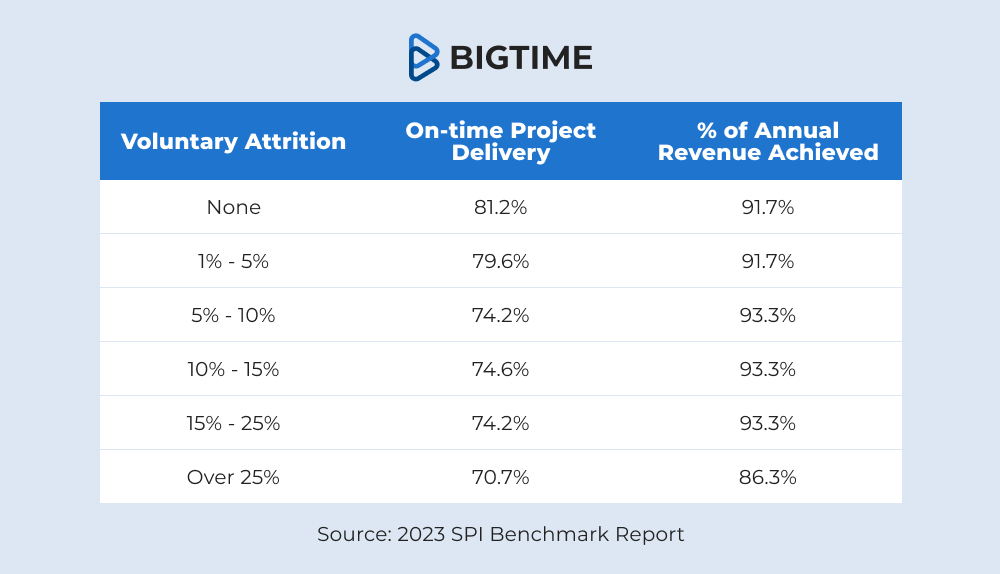
How to Track Employee Optimization
Employee Billable Utilization Rates
Track employee billable utilization rates to assess the performance of individual employees, identify high performers, and understand their contribution to the organization’s overall productivity.
Attrition Rates
Increased attrition rates may indicate issues with employee optimization in project teams, prompting a closer look at workforce dynamics to enhance project success.
Employee Satisfaction Surveys
Conduct regular surveys to gauge employee satisfaction and engagement levels. These surveys can provide insights into morale, motivation, and job satisfaction.
Performance Evaluations
Implement performance evaluations that assess employee performance, identify areas for improvement, and set goals for professional development.
Getting Quality Metrics for Project Management With PSA Software
Professional Services Automation (PSA) software is a powerful tool for helping professional services firms gain quality insights into the metrics we outlined above. From measuring revenue to improving client satisfaction, PSA software helps firms keep tabs on what’s important.
Revenue Growth
Boost revenue growth through better project management. PSA software ensures accurate handling of time, expenses, budgets, project status, and staff capacity, leading to faster business growth and increased profits. It also provides real-time data for quick insights into project budgets and future projections. Additionally, it helps in creating and tracking budgets, and supports project planning with task scheduling, dependency tracking, and milestone setting.
Organizational Profit
Increase organizational profit by optimizing how resources are used, including tracking employee billable utilization rates and skills matching. This helps ensure employees are matched with the right billable projects for maximum productivity. PSA software also analyzes project profitability and streamlines invoicing, providing valuable insights and efficiency that lead to increased billable hours and quicker payments.
Client Satisfaction
Enhance client satisfaction by improving project management and communication. PSA software provides real-time project visibility so clients can be aware of project progress, review deliverables, and provide feedback sooner. When projects are done on time and under the planned budget, you have a higher chance of repeat business and referrals.
Employee Optimization
Improve resource allocation and utilization to ensure employees are assigned to projects matching their skills and availability. This not only improves project quality but also employee job satisfaction. Additionally, PSA software tracks billable and non-billable hours, helping firms optimize employee workloads and reduce burnout. You can also keep an eye on skill gaps to identify training needs to support individual growth and career progression.
BigTime Gives You Real-Time Metrics for Project Management
It’s time to ditch the outdated methods of managing your business with spreadsheets. By investing in PSA software like BigTime, you’ll gain access to real-time reports and valuable project management insights, freeing up your time to focus on growing your business.
Findings from the BigTime Software Benchmark Report reveal just how influential BigTime can be in improving a business’s productivity, efficiency, and profitability.
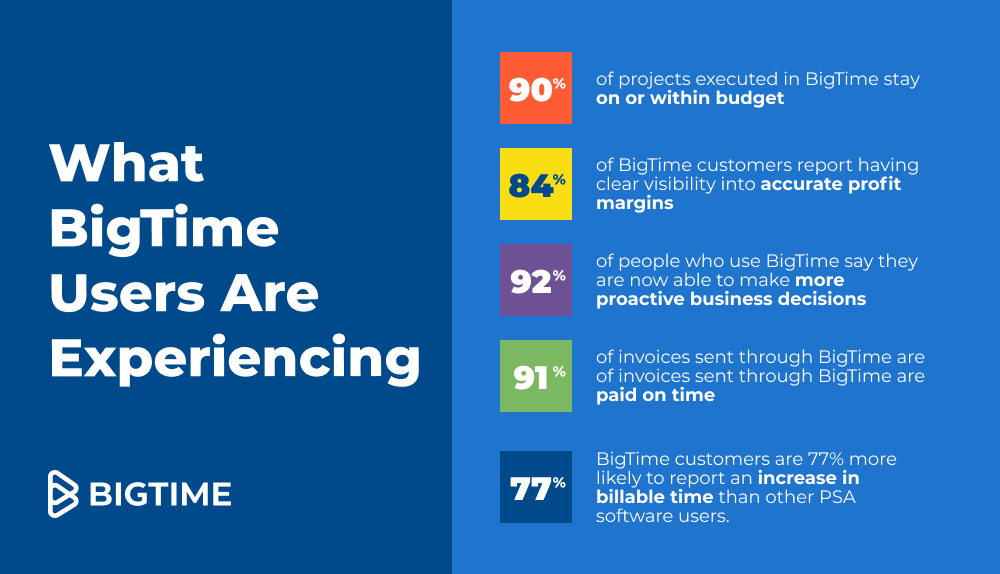

Frequently Asked Questions About Project Management Metrics
How do you track project performance?
To track project performance, you keep an eye on things like task completion, timelines, and budget use. Checking these regularly ensures the project is on track and lets you make adjustments if necessary.
What are metrics in project management?
Metrics in project management are measurable indicators that show how well a project is doing. They provide objective data to evaluate the project’s success, efficiency, and whether it’s staying on track with timelines and budgets.
What is KPI in project management?
In project management, a KPI, or Key Performance Indicator, is a specific and measurable metric used to evaluate the success and performance of a project. It provides a clear way to assess progress and whether project goals are being achieved.



